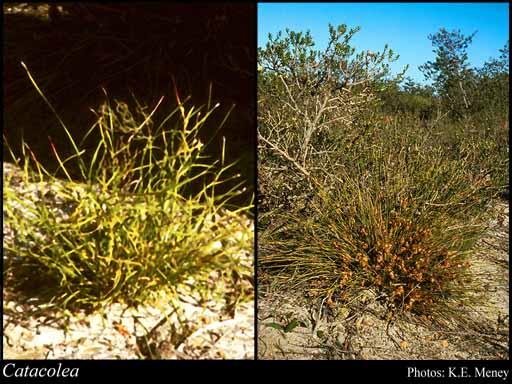- Reference
- Telopea 7:346-347 (1998)
- Name Status
- Current

Scientific Description
Family Restionaceae.
Habit and leaf form. Herbs; evergreen. Switch-plants; with the principal photosynthesizing function transferred to stems (culms). Leaves well developed, or much reduced (the blade being much reduced or absent). Perennial. Young stems strongly flattened (straight or curved, mostly of a single internode); not breaking easily at the nodes. Stem internodes solid. Rhizomatous. Leaves alternate; distichous, or spiral; leathery, or membranous; sessile; sheathing (and more or less reduced to the sheaths). Leaf sheaths with free margins (basal sheaths glossy dark brown to straw-coloured, rarely a persistent appressed sheath present mid-culm). Leaves simple; with a persistent basal meristem, and basipetal development. Vegetative anatomy. Plants with silica bodies. Leaf anatomy. Leaf blade epidermis conspicuously differentiated into ‘long’ and ‘short’ cells, or without differentiation into ‘long’ and ‘short’ cells. Guard-cells not ‘grass type’, or ‘grass type’. Stem anatomy. Secondary thickening absent.
Reproductive type, pollination. Fertile flowers functionally male, or functionally female. Unisexual flowers present. Plants dioecious. Female flowers with staminodes, or without staminodes. Male flowers with pistillodes, or without pistillodes. Floral nectaries absent (nectaries absent). Anemophilous.
Inflorescence and flower features. Flowers aggregated in ‘inflorescences’; in ‘spikelets’. Inflorescences scapiflorous, or not scapiflorous; terminal. Flowers bracteate. Bracts small, scarious. Flowers bracteolate, or ebracteolate; cyclic. Perigone tube absent. Perianth of ‘tepals’; members (4–)5(–6); 2 -whorled; isomerous, or anisomerous; sepaloid; membranous. Fertile stamens present, or absent (when female). Androecium 3. Androecial members free of the perianth; free of one another; 1 -whorled. Androecium exclusively of fertile stamens. Stamens 3; becoming exserted; oppositiperianthial (opposite the inner perianth members). Anthers dorsifixed; versatile, or non-versatile; dehiscing via longitudinal slits; introrse, or latrorse; bisporangiate, or tetrasporangiate; appendaged, or unappendaged. Pollen shed as single grains. Fertile gynoecium present, or absent (male flowers). Gynoecium 1–3 carpelled. The pistil 1 celled. Carpels isomerous with the perianth, or reduced in number relative to the perianth. Gynoecium syncarpous; synstylovarious; superior. Ovary unilocular; 1 locular; sessile to stipitate. Gynoecium stylate. Styles 1. Ovules in the single cavity 1; funicled, or sessile; pendulous; non-arillate; orthotropous.
Fruit and seed features. Fruit non-fleshy; indehiscent; a nut (shed with persistent pedicel); 1 seeded. Seeds copiously endospermic. Embryo weakly differentiated. Testa with an irregular pattern of subangular cells. Seedling. Hypocotyl internode absent. Mesocotyl absent. Seedling collar not conspicuous. Cotyledon hyperphyll elongated; assimilatory; more or less circular in t.s. Coleoptile absent. Seedling cataphylls absent. First leaf centric. Primary root ephemeral.
Additional characters Perianth of male flowers of ‘tepals’; (4–)5(–6). Perianth of female flowers of ‘tepals’; (4–)5(–6). Stems glabrous; simple; not dimorphic. Male spikelets many-flowered (c. 70-flowered, 1-several spikelets together on short, slender pendulous or patent peduncles). Female spikelets 1-flowered to several-flowered (spikelets solitary, with several sterile lower glumes). Caespitose. Female spikelets simple. Leaf sheaths 0–3.